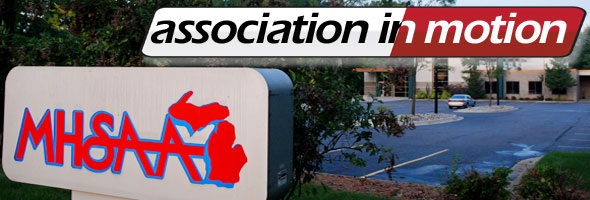
Study: Single-Sport Athletes Injured More
November 3, 2016
A study conducted by the University of Wisconsin School of Medicine and Public Health and funded by the National Federation of State High School Associations (NFHS) Foundation revealed that high school athletes who specialize in a single sport sustain lower-extremity injuries at significantly higher rates than athletes who do not specialize in one sport.
The study was conducted throughout the 2015-16 school year at 29 high schools in Wisconsin involving more than 1,500 student-athletes equally divided between male and female participants. The schools involved in the study represented a mixture of rural (14), suburban (12) and urban (3) areas, and enrollments were equally diverse with 10 small schools (less than 500 students), 10 medium schools (501-1,000 students) and nine large schools (more than 1,000 students).
Athletes who specialized in one sport were twice as likely to report previously sustaining a lower-extremity injury while participating in sports (46%) than athletes who did not specialize (24%). In addition, specialized athletes sustained 60 percent more new lower-extremity injuries during the study than athletes who did not specialize. Lower-extremity injuries were defined as any acute, gradual, recurrent or repetitive-use injury to the lower musculoskeletal system.
“While we have long believed that sport specialization by high school athletes leads to an increased risk of overuse injury, this study confirms those beliefs about the potential risks of sport specialization,” said Bob Gardner, NFHS executive director. “Coaches, parents and student-athletes need to be aware of the injury risks involved with an overemphasis in a single sport.”
Among those who reported previously sustaining a lower-extremity injury, the areas of the body injured most often were the ankle (43%) and knee (23%). The most common types of previous injuries were ligament sprains (51%) and muscle/tendon strains (20%).
New injuries during the year-long study occurred most often to the ankle (34%), knee (25%) and upper leg (13%), with the most common injuries being ligament sprains (41%), muscle/tendon strains (25%) and tendonitis (20%).
In addition, specialized athletes were twice as likely to sustain a gradual onset/repetitive-use injury than athletes who did not specialize, and those who specialized were more likely to sustain an injury even when controlling for gender, grade, previous injury status and sport.
Thirty-four (34) percent of the student-athletes involved in the Wisconsin study specialized in one sport, with females (41%) more likely to specialize than males (28%). Soccer had the highest level of specialization for both males (45%) and females (49%). After soccer, the rate of specialization for females was highest for softball (45%), volleyball (43%) and basketball (37%). The top specialization sports for males after soccer were basketball (37%), tennis (33%) and wrestling (29%).
The study, which was directed by Timothy McGuine, Ph.D., ATC, of the University of Wisconsin, also documented the effects of concurrent sport participation (participating in an interscholastic sport while simultaneously participating in an out-of-school club sport), which indicated further risk of athletes sustaining lower-extremity injuries.
Almost 50 percent of the student-athletes involved in the survey indicated they participated on a club team outside the school setting, and 15 percent of those individuals did so while simultaneously competing in a different sport within the school. Seventeen (17) percent of the student-athletes indicated that they took part in 60 or more primary sport competitions (school and club) in a single year. Among those student-athletes in this group who sustained new lower-extremity injuries during the year, 27 percent were athletes who specialized in one sport.
The student-athletes involved in the study were deemed “specialized” if they answered “yes” to at least four of the following six questions: 1) Do you train more than 75 percent of the time in your primary sport?; 2) Do you train to improve skill and miss time with friends as a result?; 3) Have you quit another sport to focus on one sport?; 4) Do you consider your primary sport more important than your other sports?; 5) Do you regularly travel out of state for your primary sport?; 6) Do you train more than eight months a year in your primary sport?
Although some sports (field hockey, lacrosse) are not offered in Wisconsin and were not included in the study, the study concluded that since specialization increased the risk of lower-extremity injuries in sports involved in the survey it would also likely increase the risk of injuries in sports that were not a part of the study.

MHSAA 2025-26 School Year Classifications Announced
By
Geoff Kimmerly
MHSAA.com senior editor
April 7, 2025
Classifications for Michigan High School Athletic Association elections and postseason tournaments for the 2025-26 school year have been announced, with enrollment breaks for postseason tournaments posted to each sport’s page on the MHSAA Website.
Classifications for the upcoming school year are based on a second semester count date, which for MHSAA purposes was Feb. 12. The enrollment figure submitted for athletic classification purposes may be different from the count submitted for school aid purposes, as it does not include students ineligible for athletic competition because they reached their 19th birthday prior to Sept. 1 of the current school year and will not include alternative education students if none are allowed athletic eligibility by the local school district.
All sports’ tournaments are conducted with schools assigned to equal or nearly equal divisions, with lines dependent on how many schools participate in those respective sports.
For 2025-26, there are 754 tournament-qualified member schools. Schools recently were notified of their classification, and sport-by-sport divisions were posted to the MHSAA Website today. MHSAA Executive Director Mark Uyl said a school may not subsequently lower its enrollment figure. However, if a revised enrollment figure is higher and indicates that a school should be playing in a higher division, that school would be moved up.
Three MHSAA Finals champions crowned during the first two seasons of this 2024-25 school year are set to move to new divisions for 2025-26. The Orchard Lake St. Mary’s (11-player Division 2) and Deckerville (8-player Division 1) football teams won titles in November but will move into 11-player Division 3 and 8-player Division 2, respectively, this upcoming season. Holland Christian’s boys tennis team – champion in Lower Peninsula Division 4 this past fall – will move into Lower Peninsula Division 3.
Schools also may request to play in a higher classification or division in a sport for a minimum of two years. Requests to opt up in fall sports for 2025-26 must be submitted by May 1, winter sports by Aug. 14 and spring sports by Oct. 15
Visit the respective sport pages on the MHSAA Website to review the divisional alignments for all MHSAA-sponsored tournament sports. Click the “SPORTS” menu at the top of this page to access the page for each sport, then the “Assignments” link on the selected sport page and then “DIVISION LIST” to see the 2025-26 division. Boys volleyball, which will begin play with MHSAA sponsorship in 2025-26, will be classified in September, providing more time to identify the number of schools that will have varsity teams in that sport for its inaugural season.
Traditional classes (A, B, C, D) – formerly used to establish tournament classifications – are used only for MHSAA elections. To determine traditional classifications, after all counts are submitted, tournament-qualified member schools are ranked according to enrollment and then split as closely into quarters as possible. For 2025-26, there are 188 member schools each in Class A and Class B, and 189 member schools each in Class C and Class D.
Effective with the 2025-26 school year, schools with 788 or more students are in Class A. The enrollment limits for Class B are 370-787, Class C is 171-369, and schools with enrollments of 170 and fewer are Class D. The break between Classes A and B decreased five students from 2024-25, the break between Classes B and C decreased eight students, and the break between Classes C and D is two students higher than for the 2024-25 school year.
The new classification breaks will see 22 schools move up in Class for 2025-26 while 22 schools will move down:
Moving Up from Class B to Class A
Adrian
Bloomfield Hills Marian
Fruitport
Hastings
Marysville
Niles
Owosso
Moving Down from Class A to Class B
Battle Creek Harper Creek
Detroit East English
Linden
Sault Ste. Marie
Sparta
St. Johns
Wayland
Moving Up from Class C to Class B
Clawson
Detroit Central
Hartford
Kent City
Napoleon
Taylor Prep
Warren Michigan Collegiate
Moving Down from Class B to Class C
Clinton Township Clintondale
Constantine
Erie Mason
Fennville
Ishpeming Westwood
Ovid-Elsie
Quincy
Moving Up from Class D to Class C
Benton Harbor Countryside Academy
Detroit Crockett Midtown Science & Medicine
Kalamazoo Phoenix
Fulton
New Buffalo
New Haven Merritt Academy
Traverse City Greenspire
Ubly
Moving Down from Class C to Class D
Ann Arbor Central Academy
Eau Claire
Fowler
Ishpeming
Marine City Cardinal Mooney
Southfield Manoogian
Three Oaks River Valley
Whittemore-Prescott
New Postseason-Eligible Tournament Schools in 2025-26
Ann Arbor Michigan Islamic Academy
Athens Factoryville Christian
Flint Cultural Center
Enrollment Breaks by Classes – 2025-26
(Number of schools in parentheses)
Class A: 788 and above (188 schools)
Class B: 370 – 787 (188)
Class C: 171 – 369 (189)
Class D: 170 and below (189)
The MHSAA is a private, not-for-profit corporation of voluntary membership by more than 1,500 public and private senior high schools and junior high/middle schools which exists to develop common rules for athletic eligibility and competition. No government funds or tax dollars support the MHSAA, which was the first such association nationally to not accept membership dues or tournament entry fees from schools. Member schools which enforce these rules are permitted to participate in MHSAA tournaments, which attract more than 1.4 million spectators each year.

